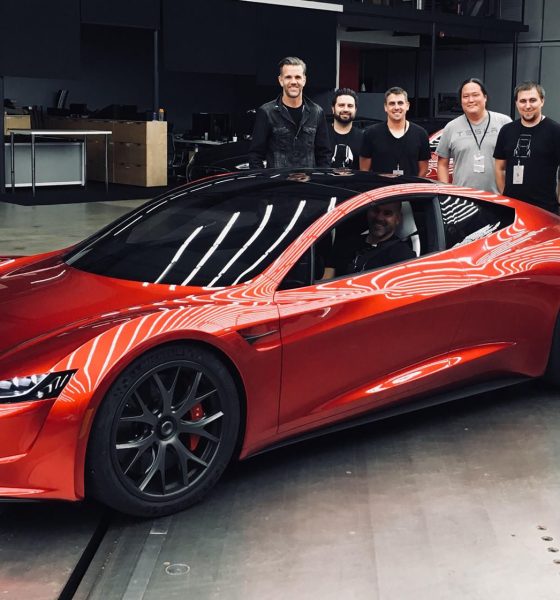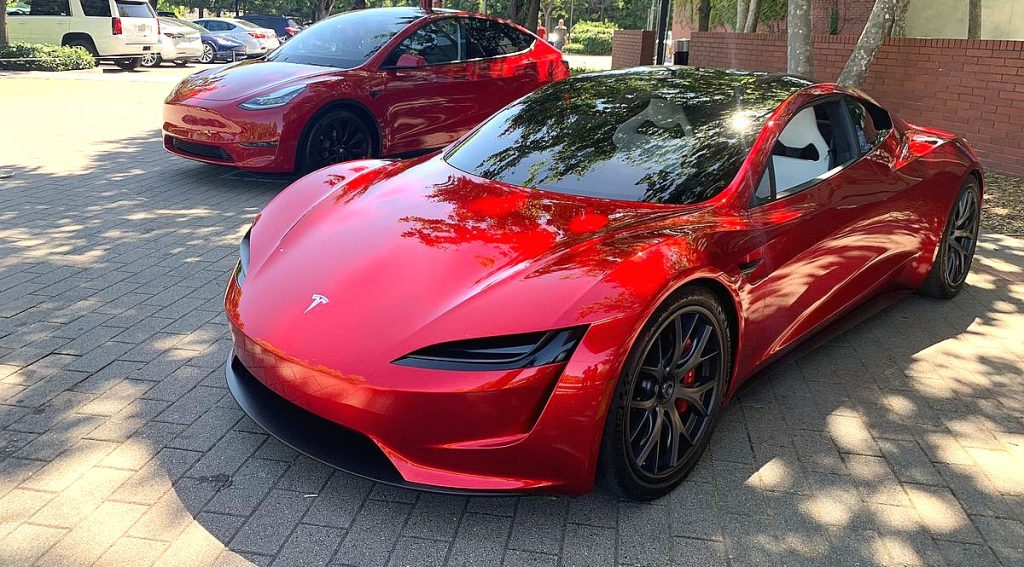

News
Tesla Roadster production car will exceed insane prototype ‘in every way:’ Chief of Design
Tesla Chief Designer Franz von Holzhausen recently made a rare appearance at owner-enthusiast Ryan McCaffrey’s Ride the Lightning podcast, where he provided several key insights into the electric car maker’s design process from the early days of the Model S to the upcoming next-generation Roadster.
While speaking about Tesla’s “halo” vehicle, von Holzhausen mentioned that the all-electric supercar has been in a process of evolution since it was unveiled. The designer added that these changes will make the production vehicle even more impressive than the already-insane prototype that came out of the Tesla Semi’s trailer nearly two years ago.
“It’s evolving deservedly so; it needs more time. It will be even better than what we’ve unveiled. In every way,” Franz said.
Considering the specs of the next-generation Tesla Roadster that were announced during its unveiling, Franz’s statements are very exciting. The initial specs of the next-gen Roadster, after all, are already bordering on insane, with its 0-60 mph time of 1.9 seconds, its top speed of over 250 mph, and its range of 620 miles per charge due to its 200 kWh battery.

These specs already place the next-gen Roadster head and shoulders above the competition, while putting the vehicle well into the performance of the auto industry’s most esteemed hypercars. Thus, it is quite difficult to wrap one’s head around the idea that the production version of the all-electric car will be a more extreme vehicle.
For Franz, the Roadster is ultimately a passion project. Describing the moment he drove out of the Tesla Semi’s trailer as a “One More Thing” surprise during the all-electric long-hauler’s unveiling event, Franz stated that the experience was memorable, partly due to how impressive the vehicle was.
“It’s an amazing machine. That car is like no other. I think it showcases the ability of what an electric vehicle can be… Being able to finally show people that — that was a cool moment,” he said.
Inasmuch as the idea of a more extreme next-generation Roadster might seem ludicrous (or is it Plaid?), Tesla actually has a reputation for doing the very same thing. The Model 3, for example, was initially announced to have a 0-60 mph time of “less than 6 seconds” during its unveiling event. Even the vehicle’s “slowest” trim, the Standard Range variant that’s available off-menu, has a 0-60 mph time of 5.6 seconds. That’s a hair faster than the BMW 730d M-Sport.

Franz’s recent comments echo those of CEO Elon Musk’s when he discussed the Roadster in his guest appearance at the Ride the Lightning podcast a few months ago. While speaking about the vehicle then, Musk stated that the next-gen Roadster will reach a level of performance that is almost unfair to gasoline or diesel-powered cars.
“We’re going to do things with the new Roadster that are kind of unfair to other cars. (It’s) crushingly good relative to the next best gasoline sports car,” Musk said.
Tesla CEO Elon Musk has stated that the next-generation Tesla Roadster will only see a production of about 10,000 units per year. That’s far above the output of niche all-electric hypercar makers such as Rimac, but it’s still very low compared to the annual production of the Model S, X, and Model 3. With this in mind, and with a $200,000 starting price that is on the same ballpark as a moderately-equipped Porsche Taycan Turbo S, there is a pretty good chance that Tesla’s “hardcore smackdown to gasoline-powered cars” will see great demand well into its release.
Ryan McCaffrey’s interview with Tesla Chief Designer Franz von Holzhausen at the Ride the Lightning podcast could be accessed here.

News
Tesla FSD Supervised wins MotorTrend’s Best Driver Assistance Award
The decision marks a notable reversal for the publication from prior years, with judges citing major real-world improvements that pushed Tesla’s latest FSD software ahead of every competing ADAS system.

Tesla’s Full Self-Driving (Supervised) system has been named the best driver-assistance technology on the market, earning top honors at the 2026 MotorTrend Best Tech Awards.
The decision marks a notable reversal for the publication from prior years, with judges citing major real-world improvements that pushed Tesla’s latest FSD software ahead of every competing ADAS system. And it wasn’t even close.
MotorTrend reverses course
MotorTrend awarded Tesla FSD (Supervised) its 2026 Best Tech Driver Assistance title after extensive testing of the latest v14 software. The publication acknowledged that it had previously criticized earlier versions of FSD for erratic behavior and near-miss incidents, ultimately favoring rivals such as GM’s Super Cruise in earlier evaluations.
According to MotorTrend, the newest iteration of FSD resolved many of those shortcomings. Testers said v14 showed far smoother behavior in complex urban scenarios, including unprotected left turns, traffic circles, emergency vehicles, and dense city streets. While the system still requires constant driver supervision, judges concluded that no other advanced driver-assistance system currently matches its breadth of capability.
Unlike rival systems that rely on combinations of cameras, radar, lidar, and mapped highways, Tesla’s FSD operates using a camera-only approach and is capable of driving on city streets, rural roads, and freeways. MotorTrend stated that pure utility, the ability to handle nearly all road types, ultimately separated FSD from competitors like Ford BlueCruise, GM Super Cruise, and BMW’s Highway Assistant.
High cost and high capability
MotorTrend also addressed FSD’s pricing, which remains significantly higher than rival systems. Tesla currently charges $8,000 for a one-time purchase or $99 per month for a subscription, compared with far lower upfront and subscription costs from other automakers. The publication noted that the premium is justified given FSD’s unmatched scope and continuous software evolution.
Safety remained a central focus of the evaluation. While testers reported collision-free operation over thousands of miles, they noted ongoing concerns around FSD’s configurable driving modes, including options that allow aggressive driving and speeds beyond posted limits. MotorTrend emphasized that, like all Level 2 systems, FSD still depends on a fully attentive human driver at all times.
Despite those caveats, the publication concluded that Tesla’s rapid software progress fundamentally reshaped the competitive landscape. For drivers seeking the most capable hands-on driver-assistance system available today, MotorTrend concluded Tesla FSD (Supervised) now stands alone at the top.
News
Elon Musk’s Grokipedia surges to 5.6M articles, almost 79% of English Wikipedia
The explosive growth marks a major milestone for the AI-powered online encyclopedia, which was launched by Elon Musk’s xAI just months ago.

Elon Musk’s Grokipedia has grown to an impressive 5,615,201 articles as of today, closing in on 79% of the English Wikipedia’s current total of 7,119,376 articles.
The explosive growth marks a major milestone for the AI-powered online encyclopedia, which was launched by Elon Musk’s xAI just months ago. Needless to say, it would only be a matter of time before Grokipedia exceeds English Wikipedia in sheer volume.
Grokipedia’s rapid growth
xAI’s vision for Grokipedia emphasizes neutrality, while Grok’s reasoning capabilities allow for fast drafting and fact-checking. When Elon Musk announced the initiative in late September 2025, he noted that Grokipedia would be an improvement to Wikipedia because it would be designed to avoid bias.
At the time, Musk noted that Grokipedia “is a necessary step towards the xAI goal of understanding the Universe.”
Grokipedia was launched in late October, and while xAI was careful to list it only as Version 0.1 at the time, the online encyclopedia immediately earned praise. Wikipedia co-founder Larry Sanger highlighted the project’s innovative approach, noting how it leverages AI to fill knowledge gaps and enable rapid updates. Netizens also observed how Grokipedia tends to present articles in a more objective manner compared to Wikipedia, which is edited by humans.
Elon Musk’s ambitious plans
With 5,615,201 total articles, Grokipedia has now grown to almost 79% of English Wikipedia’s article base. This is incredibly quick, though Grokipedia remains text-only for now. xAI, for its part, has now updated the online encyclopedia’s iteration to v0.2.
Elon Musk has shared bold ideas for Grokipedia, including sending a record of the entire knowledge base to space as part of xAI’s mission to preserve and expand human understanding. At some point, Musk stated that Grokipedia will be renamed to Encyclopedia Galactica, and it will be sent to the cosmos.
“When Grokipedia is good enough (long way to go), we will change the name to Encyclopedia Galactica. It will be an open source distillation of all knowledge, including audio, images and video. Join xAI to help build the sci-fi version of the Library of Alexandria!” Musk wrote, adding in a later post that “Copies will be etched in stone and sent to the Moon, Mars and beyond. This time, it will not be lost.”
News
Tesla Model 3 becomes Netherlands’ best-selling used EV in 2025
More than one in ten second-hand electric cars sold in the country last year was a Tesla Model 3.

The Tesla Model 3 became the most popular used electric car in the Netherlands in 2025, cementing its dominance well beyond the country’s new-car market.
After years at the top of Dutch EV sales charts, the Model 3 now leads the country’s second-hand EV market by a wide margin, as record used-car purchases pushed electric vehicles further into the mainstream.
Model 3 takes a commanding lead
The Netherlands recorded more than 2.1 million used car sales last year, the highest level on record. Of those, roughly 4.8%, or about 102,000 vehicles, were electric. Within that growing segment, the Tesla Model 3 stood far ahead of its competitors.
In 2025 alone, 11,338 used Model 3s changed hands, giving the car an 11.1% share of the country’s entire used EV market. That means more than one in ten second-hand electric cars sold in the country last year was a Tesla Model 3, Auto Week Netherlands reported. The scale of its lead is striking: the gap between the Model 3 and the second-place finisher, the Volkswagen ID3, is more than 6,700 vehicles.
Rivals trail as residual values shape rankings
The Volkswagen ID.3 ranked a distant second, with 4,595 used units sold and a 4.5% market share. Close behind was the Audi e-tron, which placed third with 4,236 registrations. As noted by Auto Week Netherlands, relatively low residual values likely boosted the e-tron’s appeal in the used market, despite its higher original price.
Other strong performers included the Kia Niro, the Tesla Model Y, and the Hyundai Kona, highlighting continued demand for compact and midsize electric vehicles with proven range and reliability. No other model, however, came close to matching the Model 3’s scale or market presence.








